 |
| newsnetwork.mayoclinic.org |
 |
| theconversation.com |
Genetics, the disease, in all forms, has been noticed to transition through genetic or family bloodlines. Injuries, if left unacknowledged, joint injuries, even if they appear to be alright and treated properly, can soon develop arthritis if the joint is repeatedly injured and constantly has weight on it.
Weight, if the skeleton endures an unhealthy amount of weight on the joints it can press the bones in the joints closer together, letting the cartilage wear away even quicker than the anticipated rate for more common forms of arthritis.
Age, it has been identified with arthritis that people over 65 have an around fifty percent chance to develop the disease in their joints if they haven't experienced it or are experiencing it already.
Repetitive actions, such as lifting boxes from one place to another, applies constant strain onto the joints in use, especially if it is for an extended period and then the person proceeds to lay down and not exercise the joints or use them.
 |
| A case of Rheumatoid Arthritis. gettyimages.fi |
There are many myths surrounding arthritis and how you can get it, especially one of the more common ones like 'If you crack your knuckles, you will get arthritis', this is in fact, false. My science teacher told me so so you can bring it up with him. But, there are many other myths surrounding arthritis and how it can affect your body. There are other myths than the ones I will bring up here, if you wish to look over the others they will be from the sources I will have.
- Only older people get arthritis, this is incorrect. There are over 300,000 cases of infants, children, and teenagers, having the disease in its different forms in their earlier stages of life.
- All pain in the joints is arthritis, this is incorrect. There are other conditions such as tendonitis and even in some cases, it can be simple as soft tissue damage that can appear to be arthritis at first.
- Taking it easy is the best thing for arthritis, this is incorrect. Regular exercise without overuse of the joint can be helpful to treat the joint, it is not a cure though.
- There is nothing you can do about arthritis, this is incorrect. While there is not an absolute cure for arthritis, regular exercise, reducing weight, having both time to relax and time to be active, sleeping well and having a healthier diet can assist, but not provide any medical cure, with arthritis.
- Applying heat to the joint is better than applying ice, this is incorrect. Both elements can help with the pain of arthritis in different situations, heat can be better for joints in the mornings while icing the pain can be more helpful before going to sleep. Both assist in dealing with the pain though.
Sources -
No comments:
Post a Comment
Note: only a member of this blog may post a comment.